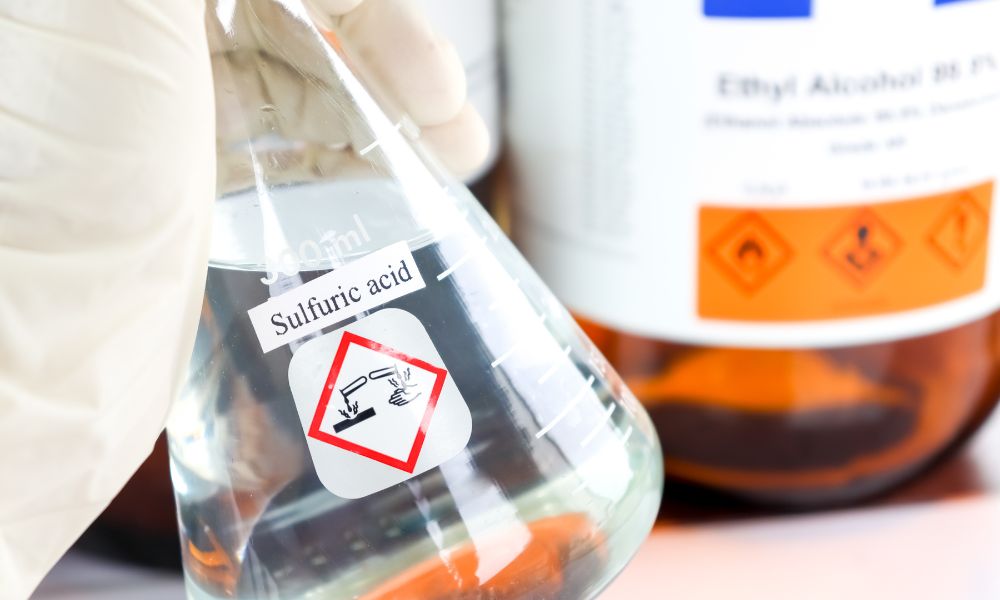All professionals who work with chemicals must understand the importance of safety and proper handling. Sulfuric acid is one common chemical that requires careful attention as it is a highly corrosive and hazardous substance. Because this chemical can be hazardous, it requires careful handling and preparation for disposal.
Neutralizing sulfuric acid solutions is a crucial step in managing chemical spills, preventing environmental damage, and ensuring the safety of laboratory professionals and manufacturers. Understanding the properties of sulfuric acid and the neutralization process is essential for anyone working with this potent substance. Learn how to neutralize sulfuric acid solutions safely and effectively to properly handle and dispose of them in your laboratory or other workplace.
What Is Sulfuric Acid?
Sulfuric acid is a highly potent and corrosive substance that is infamous for its aggressive properties, including its highly corrosive elements and health hazards. This strong acid is highly reactive to a wide range of materials, including metals, organic compounds, and even some nonmetals. Its caustic nature means it can cause severe burns upon direct contact with the skin, leading to long-lasting tissue damage. Moreover, sulfuric acid’s toxic fumes pose significant risks to human health and the environment, necessitating utmost caution and adherence to proper handling protocols. Neutralizing this hazardous substance is of utmost importance to create and maintain a safe working environment, ensuring the well-being of individuals and safeguarding the integrity of surrounding structures and equipment.
What Is the Neutralization Process?
Neutralization is an essential chemical reaction that results when combining an acid with a base, creating a type of salt and water. This process neutralizes the acidic properties of the solution, mitigating its potential hazards. We can reduce sulfuric acid’s acidity and eliminate the risks of handling and disposing of it by introducing a suitable neutralizing agent to a sulfuric acid solution. Doing so ensures a safer working environment and contributes to the efficiency and effectiveness of the chemical processes involved.
Why Is It Important To Neutralize Sulfuric Acid?
Neutralizing sulfuric acid solutions serves multiple purposes. We minimize the risk of accidental spills and exposure to highly corrosive substances by carefully neutralizing these solutions with suitable bases such as sodium hydroxide or calcium carbonate. Neutralizing hazardous sulfuric acid solutions also safeguards your equipment’s integrity, infrastructure, and the environment. This crucial step ensures the long-term durability and functionality of storage containers, transport systems, and other critical components handling and storing sulfuric acid. Additionally, neutralization plays a significant role in maintaining the pH balance of wastewater treatment systems, preventing adverse effects on aquatic life and ecosystem health. Thus, we contribute to a safer and more sustainable local environment by neutralizing sulfuric acid solutions effectively.
What Neutralizes Sulfuric Acid?
Several agents can effectively neutralize sulfuric acid solutions. Some common neutralizing agents include sodium bicarbonate, calcium carbonate, and sodium hydroxide. Each neutralizing agent has its advantages and considerations, so it is important to choose the appropriate agent based on the specific situation. Which neutralizing agent you choose depends on factors such as the acid’s concentration percentage. It is important to select an appropriate neutralizing agent and follow the recommended proportions for effective neutralization.
Neutralization Methods for Sulfuric Acid Solutions
Follow these basic steps to safely neutralize sulfuric acid solutions:
- Prepare a neutralizing solution by carefully dissolving a precisely measured amount of the chosen neutralizing agent in water. Doing so ensures the correct concentration for effective neutralization.
- Gradually and slowly add the prepared neutralizing solution to the sulfuric acid solution. Stir continuously during this process to facilitate thorough mixing and reaction between the two substances.
- Regularly monitor the pH level using either pH paper or a pH meter. These pH monitors allow you to track the neutralization progress and achieve the desired pH level. This portion of the neutralization process requires your time and patience.
- Once the neutralization process is complete and your solution reaches the desired pH level, adhere to local regulations when disposing of the neutralized solution. Every laboratory and manufacturing facility using chemicals should understand the local disposal laws and guidelines to maintain safety and legal compliance.
You can effectively neutralize sulfuric acid solutions while prioritizing safety and environmental responsibility by following these steps.
Common Neutralization Mistakes To Avoid
While neutralizing sulfuric acid solutions, be aware of common mistakes that can compromise safety. Some common mistakes to avoid during the neutralization process include:
- Never add the neutralizing agent too quickly, as doing so can lead to excessive heat generation and potential splattering.
- Never use an incorrect quantity of neutralizing agent, as it can result in incomplete neutralization or an over-neutralized solution. Always carefully measure your neutralizing agent and compare it with supplier guidelines for neutralization.
- Never skip testing the pH level during the neutralization process. Skipping this step can lead to inaccuracies and potential hazards.
Neutralizing Sulfuric Acid on Different Surfaces
The neutralization process may vary depending on the surface or material that encounters sulfuric acid. For example, sulfuric acid may react differently when contacting various materials, such as concrete, metal, plastic, and skin. A two-step process involving rinsing and neutralization is often necessary to ensure complete and safe neutralization.
Safety Tips for Working With Sulfuric Acid
Working with sulfuric acid requires strict adherence to safety precautions. Always wear appropriate personal protective equipment (PPE) such as gloves, goggles, and a lab coat. Work in a well-ventilated area to minimize exposure to acidic fumes. Ensure you are familiar with emergency protocols and have access to safety showers and eyewash stations. Prioritize safety to minimize risks associated with handling sulfuric acid.
Here are some additional safety tips to keep in mind when working with sulfuric acid:
- Store sulfuric acid in a well-ventilated area, away from incompatible substances.
- Handle sulfuric acid containers with care, ensuring you seal them tightly and properly label them.
- Always add acid to water when diluting concentrated sulfuric acid to avoid splashing or violent reactions.
- Dispose of waste solutions following local regulations and guidelines.
- Regularly inspect and maintain storage and handling equipment to prevent leaks or spills.
Neutralizing sulfuric acid solutions is a critical step in ensuring safety and minimizing environmental impact. You can handle and dispose of sulfuric acid solutions safely and responsibly by following these steps to neutralize sulfuric acid, adhering to safety precautions, and avoiding common mistakes. Remember to prioritize safety and consult experts or professionals when dealing with large-scale neutralization processes. You contribute to a safer working environment and help protect our surroundings from the potential hazards of sulfuric acid by doing so.
Obtaining your chemicals from a reputable and experienced source is key when working with hazardous acids like this. Trust Post Apple Scientific as your supplier if your business is looking for a reliable source for where to buy sulfuric acid. Browse our selection of chemical agents today to learn more about sulfuric acid and its properties.


